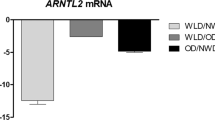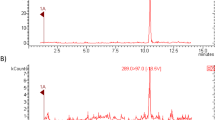Abstract
Objective:
To analyze, in morbid obese patients, the expression of several human genes regulating cortisol metabolism, such as glucocorticoid receptor (GR), 11β-hydroxysteroid dehydrogenase type 1 (11βHSD1), 11β-hydroxysteroid dehydrogenase type 2 (11βHSD2), stearoyl-acute regulatory protein (StAR), 5α-reductase type I (5α-R) and peroxisome proliferator-activated receptor-γ (PPARγ) in two different adipose depots. A second objective was to characterize the circadian rhythmicity of these genes in both adipose tissue (AT) regions.
Design:
Visceral and subcutaneous abdominal AT biopsies were obtained from obese patients (body mass index ⩾40 kg m−2). To carry out rhythmic expression analysis, AT explants were cultured for 24 h and gene expression at times (T) 0, 6, 12 and 18 h, was performed with quantitative real-time PCR.
Result:
GR, 11βHSD1 and PPARγ genes were highly expressed in both subcutaneous and visceral depots. StAR and 5α-R genes were detected at lower levels. The expression of 11βHSD2 was quantified in both AT depots with a higher expression in the visceral depot (P=0.032). Both sexes had similar gene expression levels, except for 5α-R (P=0.002). The genes studied showed circadian rhythmicity being more robust in visceral than in subcutaneous AT. Genes ranged in anti-phase between both depots (P=0.002). This rhythmicity was maintained in an AT culture.
Conclusion:
We have shown for the first time circadian rhythmicity in glucocorticoid-related gene expression in human AT ex vivo. These results may have potential therapeutic implications with respect to the pathogenesis and treatment of diseases, such as obesity, type 2 diabetes and cardiovascular diseases.
This is a preview of subscription content, access via your institution
Access options
Subscribe to this journal
Receive 12 print issues and online access
$259.00 per year
only $21.58 per issue
Buy this article
- Purchase on Springer Link
- Instant access to full article PDF
Prices may be subject to local taxes which are calculated during checkout




Similar content being viewed by others
References
Hamdy O, Porramatikul S, Al-Ozairi E . Metabolic obesity: the paradox between visceral and subcutaneous fat. Curr Diabetes Rev 2006; 2: 367–373.
Bujalska IJ, Kumar S, Stewart PM . Does central obesity reflect ‘Cushing's disease of the omentum’? Lancet 1997; 349: 1210–1213.
Westerbacka J, Yki-Järvinen H, Vehkavaara S, Häkkinen AM, Andrew R, Wake DJ et al. Body fat distribution and cortisol metabolism in healthy men: enhanced 5betareductase and lower cortisol/cortisone metabolite ratios in men with fatty liver. J Clin Endocrinol Metab 2003; 88: 4924–4931.
Fraser R, Ingram MC, Anderson NH, Morrison C, Davies E, Connell JM . Cortisol effects on body mass, blood pressure, and cholesterol in the general population. Hypertension 1999; 33: 1364–1368.
García-Prieto MD, Tébar FJ, Nicolás F, Larqué E, Zamora S, Garaulet M . Cortisol secretary pattern and glucocorticoid feedback sensitivity in women from a Mediterranean area: relationship with anthropometric characteristics, dietary intake and plasma fatty acid profile. Clin Endocrinol (Oxf) 2007; 66: 185–191.
Liu AC, Lewis WG, Kay SA . Mammalian circadian signaling networks and therapeutic targets. Nat Chem Biol 2007; 3: 630–639.
Blouin K, Richard C, Brochu G, Hould FS, Lebel S, Marceau S et al. Androgen inactivation and steroid-converting enzyme expression in abdominal adipose tissue in men. J Endocrinol 2006; 191: 637–649.
Pezzi V, Mathis JM, Rainey WE, Carr BR . Profiling transcript levels for steroidogenic enzymes in fetal tissues. J Steroid Biochem Mol Biol 2003; 87: 181–189.
Schinner S, Willenberg HS, Krause D, Schott M, Lamounier-Zepter V, Krug AW et al. Adipocyte-derived products induce the transcription of the StAR promoter and stimulate aldosterone and cortisol secretion from adrenocortical cells through the Wnt-signaling pathway. Int J Obes (London) 2007; 31: 864–870.
Livingstone DE, Jones GC, Smith K, Jamieson PM, Andrew R, Kenyon CJ et al. Understanding the role of glucocorticoids in obesity: tissue-specific alterations of corticosterone metabolism in obese Zucker rats. Endocrinology 2000; 141: 560–563.
Tomlinson JW, Moore J, Cooper MS, Bujalska I, Shahmanesh M, Burt C et al. Regulation of expression of 11beta-hydroxysteroid dehydrogenase type 1 in adipose tissue: tissue-specific induction by cytokines. Endocrinology 2001; 142: 1982–1989.
Blouin K, Richard C, Brochu G, Hould FS, Lebel S, Marceau S et al. Androgen inactivation and steroid-converting enzyme expression in abdominal adipose tissue in men. J Endocrinol 2006; 191: 637–649.
Li X, Lindquist S, Chen R, Myrnäs T, Angsten G, Olsson T et al. Depot-specific messenger RNA expression of 11 beta-hydroxysteroid dehydrogenase type 1 and leptin in adipose tissue of children and adults. Int J Obes (London) 2007; 31: 820–828.
Paulsen SK, Pedersen SB, Fisker S, Richelsen B . 11Beta-HSD type 1 expression in human adipose tissue: impact of gender, obesity, and fat localization. Obesity (Silver Spring) 2007; 15: 1954–1960.
Mackenzie SM, Huda SS, Sattar N, Fraser R, Connell JM, Davies E . Depot-specific steroidogenic gene transcription in human adipose tissue. Clin Endocrinol (Oxf) 2008; 69: 848–854.
Milagro FI, Campión J, Martínez JA . 11-Beta hydroxysteroid dehydrogenase type 2 expression in white adipose tissue is strongly correlated with adiposity. J Steroid Biochem Mol Biol 2007; 104: 81–84.
Ritchie JD, Miller CK, Smiciklas-Wright H . Tanita foot-to-foot bioelectrical impedance analysis system validated in older adults. J Am Diet Assoc 2005; 105: 1617–1619.
Hernandez-Morante JJ, Milagro F, Gabaldon JA, Martinez JA, Zamora S, Garaulet M . Effect of DHEA-sulfate on adiponectin gene expression in adipose tissue from different fat depots in morbidly obese humans. Eur J Endocrinol 2006; 155: 593–600.
Livak KJ, Schmittgen TD . Analysis of relative gene expression data using real-time quantitative PCR and the 2(−Delta Delta C(T)) method. Methods 2001; 25: 402–408.
Marrades MP, Milagro FI, Martinez JA, Moreno-Aliaga MJ . Differential expression of aquaporin 7 in adipose tissue of lean and obese high fat consumers. Biochem Biophys Res Commun 2006; 339: 785–789.
Stimson RH, Walker BR . Glucocorticoids and 11beta-hydroxysteroid dehydrogenase type 1 in obesity and the metabolic syndrome. Minerva Endocrinol 2007; 32: 141–159.
Tomlinson JW, Sinha B, Bujalska I, Hewison M, Stewart PM . Expression of 11β-hydroxysteroid dehydrogenase type 1 in adipose tissue is not increased in human obesity. J Clin Endocrinol Metab 2002; 87: 5630–5635.
Campión J, Milagro FI, Fernández D, Martínez JA . Vitamin C supplementation influences body fat mass and steroidogenesis related genes when fed a high fat diet. Int J Vitam Nutr Res 2008; 78: 87–95.
Walker BR . 11-b-Hydroxysteroid dehydorgenase type 1 in obesity. Obesity Res 2004; 12: 1–3.
Engeli S, Böhnke J, Feldpausch M, Gorzelniak K, Heintze U, Janke J et al. Regulation of 11beta-HSD genes in human adipose tissue: influence of central obesity and weight loss. Obes Res 2004; 12: 9–17.
Yang K, Khalil MW, Strutt BJ, Killinger DW . 11 Beta-hydroxysteroid dehydrogenase 1 activity and gene expression in human adipose stromal cells: effect on aromatase activity. J Steroid Biochem Mol Biol 1997; 60: 247–253.
Wake DJ, Strand M, Rask E, Westerbacka J, Livingstone DEW, Soderberg S et al. Intra-adipose sex steroid metabolism and body fat distribution in idiopathic human obesity. Clin Endocrinol 2007; 66: 440–446.
Atzmon G, Yang XM, Muzumdar R, Ma XH, Gabriely I, Barzilai N . Differential gene expression between visceral and subcutaneous fat depots. Hormone Metabolic Res 2002; 34: 622–628.
Zyirek M, Flood C, Longcope C . 5 Alpha-reductase activity in rat adipose tissue. Proc Soc Exp Biol Med 1987; 186: 134–138.
Barat P, Livingstone DE, Elferink CM, McDonnell CR, Walker BR, Andrew R . Effects of gonadectomy on glucocorticoid metabolism in obese Zucker rats. Endocrinology 2007; 148: 4836–4843.
Masuzaki H, Paterson J, Shinyama H, Morton NM, Mullins JJ, Seckl JR et al. A transgenic model of visceral obesity and the metabolic syndrome. Science 2001; 294: 2166–2170.
Drake AJ, Livingstone DE, Andrew R, Seckl JR, Morton NM, Walker BR . Reduced adipose glucocorticoid reactivation and increased hepatic glucocorticoid clearance as an early adaptation to high-fat feeding in Wistar rats. Endocrinology 2005; 146: 913–919.
Reilly DF, Curtis AM, Cheng Y, Westgate EJ, Rudic RD, Paschos G et al. Peripheral circadian clock rhythmicity is retained in the absence of adrenergic signaling. Arterioscler Thromb Vasc Biol 2008; 28: 121–126.
Bray MS, Shaw CA, Moore MW, Garcia RA, Zanquetta MM, Durgan DJ et al. Disruption of the circadian clock within the cardiomyocyte influences myocardial contractile function, metabolism, and gene expression. Am J Physiol Heart Circ Physiol 2008; 294: H1036–H1047.
Le Minh N, Damiola F, Tronche F, Schütz G, Schibler U . Glucocorticoid hormones inhibit food-induced phase-shifting of peripheral circadian oscillators. EMBO J 2001; 20: 7128–7136.
Fontaine C, Staels B . The orphan nuclear receptor Rev-erbalpha: a transcriptional link between circadian rhythmicity and cardiometabolic disease. Curr Opin Lipidol 2007; 18: 141–146.
Tomlinson JW, Stewart PM . Mechanisms of disease: selective inhibition of 11betahydroxysteroid dehydrogenase type 1 as a novel treatment for the metabolic syndrome. Nat Clin Pract Endocrinol Metab 2005; 1: 92–99.
Andrew R, Westerbacka J, Wahren J, Yki-Järvinen H, Walker BR . The contribution of visceral adipose tissue to splanchnic cortisol production in healthy humans. Diabetes 2005; 54: 1364–1370.
Acknowledgements
We thank P Gomez-Abellan for her contributions and support in AT culture development. We also thank Dr J Lujan for his technical assistance in obtaining adipose tissue.
This work was supported by the Seneca Foundation from the Government of Murcia (project 02934/PI/05 to MG) and by the Government of Education, Science and Research of Murcia (project BIO/FFA 07/01-0004).
Author information
Authors and Affiliations
Corresponding author
Rights and permissions
About this article
Cite this article
Hernandez-Morante, J., Gomez-Santos, C., Milagro, F. et al. Expression of cortisol metabolism-related genes shows circadian rhythmic patterns in human adipose tissue. Int J Obes 33, 473–480 (2009). https://doi.org/10.1038/ijo.2009.4
Received:
Revised:
Accepted:
Published:
Issue Date:
DOI: https://doi.org/10.1038/ijo.2009.4
Keywords
This article is cited by
-
The association among chronotype, timing of food intake and food preferences depends on body mass status
European Journal of Clinical Nutrition (2017)
-
Diurnal rhythms of plasma GLP-1 levels in normal and overweight/obese subjects: lack of effect of weight loss
Journal of Physiology and Biochemistry (2015)
-
The chronobiology, etiology and pathophysiology of obesity
International Journal of Obesity (2010)
-
CLOCK gene is implicated in weight reduction in obese patients participating in a dietary programme based on the Mediterranean diet
International Journal of Obesity (2010)



